It’s called Schweinshaxe and it comes with a rich, flavorful beer gravy. You say it has a piece of unbelievably tender, juicy pork meat on the bone wrapped in crispy crackling skin? Stop beating my heart!
Of the many things Germans have perfected, pork roast is right up there. And of course, great crackling is key to this meaty art. Most recipes for pork knuckle don’t do this well, but we did it!
Pork knuckle, known as schweinshaxe in German, is a delicious and hearty cut of meat that is popular in German and Austrian cuisine. With its tender, fatty meat and crispy skin, pork knuckle makes for a fabulous main course. However, no pork knuckle meal is complete without the perfect side dishes and accompaniments to complement the star of the show. In this article, we’ll explore the best sides and condiments to serve with pork knuckle for a mouthwatering German feast.
Tradition German Sides for Pork Knuckle
Potato Dumplings
Potato dumplings, known as kartoffelkloße or kartoffelknödel in German, are the quintessential accompaniment for pork knuckle. These starchy dumplings are made from potatoes, flour and eggs and are perfect for soaking up the rich gravies and sauces served with pork knuckle. They provide the ideal hearty, comforting contrast to the crisp crackling and succulent meat. Simple to make, potato dumplings can be boiled, fried or baked. Serve them plain, drizzled with butter, or topped with crispy fried onions or bacon bits.
Sauerkraut
Sauerkraut, meaning “sour cabbage” in German, is another classic partner for pork knuckle. Its distinctive sour and salty tang complements the rich, fatty flavors of the pork perfectly. Freshly made sauerkraut has crunchy texture and bright, clean flavors that cut through the unctuous meat and skin. Alternatively, simmer sauerkraut with aromatics like juniper berries, caraway seeds and apples for a more complex, cooked version.
Spätzle
These tiny German egg dumplings or noodles make for a delicious starchy accompaniment for pork knuckle. Made from flour, eggs and nutmeg, spätzle is boiled then tossed in butter or fried in clarified butter. It soaks up the meat juices and gravy beautifully. Spätzle can also be fried with bacon lardons or caramelized onions for extra flavor.
Red Cabbage
Sweet and sour braised red cabbage is another excellent contender. Slow cooked with apples, onions, vinegar and spices, red cabbage has a lovely mild tang that contrasts the rich pork. The supple texture and bursts of sweetness complement the crispy skin and savory meat perfectly.
More Pairing Ideas for Pork Knuckle
Beyond the classic German sides, pork knuckle also pairs well with a variety of other vegetable dishes and condiments.
Mashed Potatoes
Creamy, buttery mashed potatoes are never a bad idea. They soak up the meat juices and gravy splendidly. For extra flavor, fold in horseradish, roasted garlic or crisp bacon bits.
Buttered Spaetzle
These tiny German dumplings pair perfectly with pork knuckle. Boil then toss spaetzle in butter or brown butter for rich, nutty flavor.
Braised Red Cabbage
The sweet-sour flavor of braised red cabbage with apples is the ideal foil for rich pork knuckle.
Sautéed Apples
For a fresh, fruity accompaniment, sauté apples with brown butter, thyme and a pinch of cinnamon.
Green Beans
Blanched or sautéed green beans add color and freshness. Toss them in browned butter or bacon drippings.
Glazed Carrots
Sweet glazed carrots caramelized with brown sugar and butter balance the savoriness.
German Potato Salad
Warm potato salad dressed in bacon fat is comfort food at its finest.
Cucumbers in Sour Cream
Cool cucumbers in tangy sour cream or yogurt make a refreshing counterpoint.
Sauerkraut
No pork knuckle meal is complete without tangy, salty sauerkraut.
Gravy
A rich beer, onion or mushroom gravy turns this into knife-and-fork fare.
Horseradish Sauce
Horseradish sauce adds a bracing, sinus-clearing kick – perfect for cutting the richness.
Grainy Mustard
Grainy mustard with whole mustard seeds provides pungent, tangy flavor.
Tips for Serving Pork Knuckle
-
Roast the pork knuckle until the skin is very crispy and bubbles up from the fat underneath. This takes high heat – around 500°F.
-
Let the pork knuckle rest for 10-15 minutes before carving so the juices can redistribute.
-
Serve the pork knuckle on a large platter or wooden board for sharing family-style. Provide plenty of napkins!
-
Offer a sharp knife for guests to crack through the crispy skin and cut meat off the bone.
-
Round out the meal with a light starter salad such as a German potato salad or cucumber salad.
-
Allow 1 pork knuckle for every 2 hungry guests, or 1 per person for serious meat lovers!
-
Accompany with hearty German beers like dunkel, oktoberfest or bock.
Sample Menu Featuring Pork Knuckle
Here is a sample menu for a stellar German pork knuckle dinner party:
Starter
- German Potato Salad with bacon and mustard dressing
Main Course
- Crispy Pork Knuckle with Beer Gravy
- Buttered Spaetzle noodles
- Braised Red Cabbage
- Sauerkraut
Dessert
- Black Forest Cake
Suggested Drinks
- Dunkel or Bock Beer
- Riesling Wine
With the perfect balance of rich meats, hearty starches, tangy vegetables and sweet endings, this menu showcases pork knuckle at its finest. The combination of the crackling skin, tender meat and malty beer gravy is hard to beat. Pair it with fluffy spaetzle, sweet-and-sour braised cabbage and a generous helping of sauerkraut for a mouthwatering German feast. Prost!
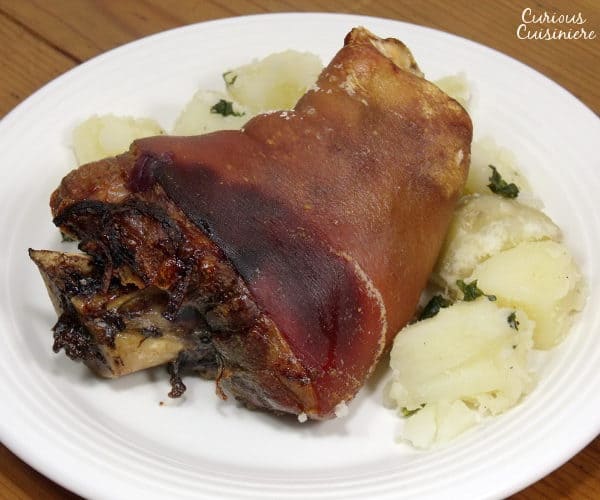
Part 4: German beer gravy
While the skin is crisping up in the oven into crackling perfection, make the beer gravy:

- Strain – Strain roasting pan juices into a saucepan. The exact amount of liquid in the pan will depend on your oven’s accuracy, the pan’s size, and other factors. But we don’t need to check the exact amount of liquid because we can change it after the cornflour or cornstarch is added. If you don’t have enough liquid, the gravy will be too thick, so just add water to make it thinner. If you have too much liquid, the gravy will be too thin, so simmer it for longer to thin it out and make it more concentrated. Aim for about 1 5 to 2 cups, but use the thickness of the gravy to figure out how much to use. And taste, of course!.
- Add cornstarch to the gravy to make it thicker. Once the volume and concentration have been changed (if needed), bring the gravy stock to a simmer. Fill a slurry pan with cornflour and water. Slowly pour the slurry into the gravy while stirring it. After that, just let it cook for two minutes until it turns into a thin syrup. For Pork Knuckle, the beer gravy shouldn’t be as thick as the English-style gravy you serve with roast pork or lamb. See above for adjusting thickness as required. Put the gravy in a jug and serve with the pork knuckle. Or, put it on the plate the old-fashioned way: pour a big pool of gravy in the middle and then place the knuckle on top of it.
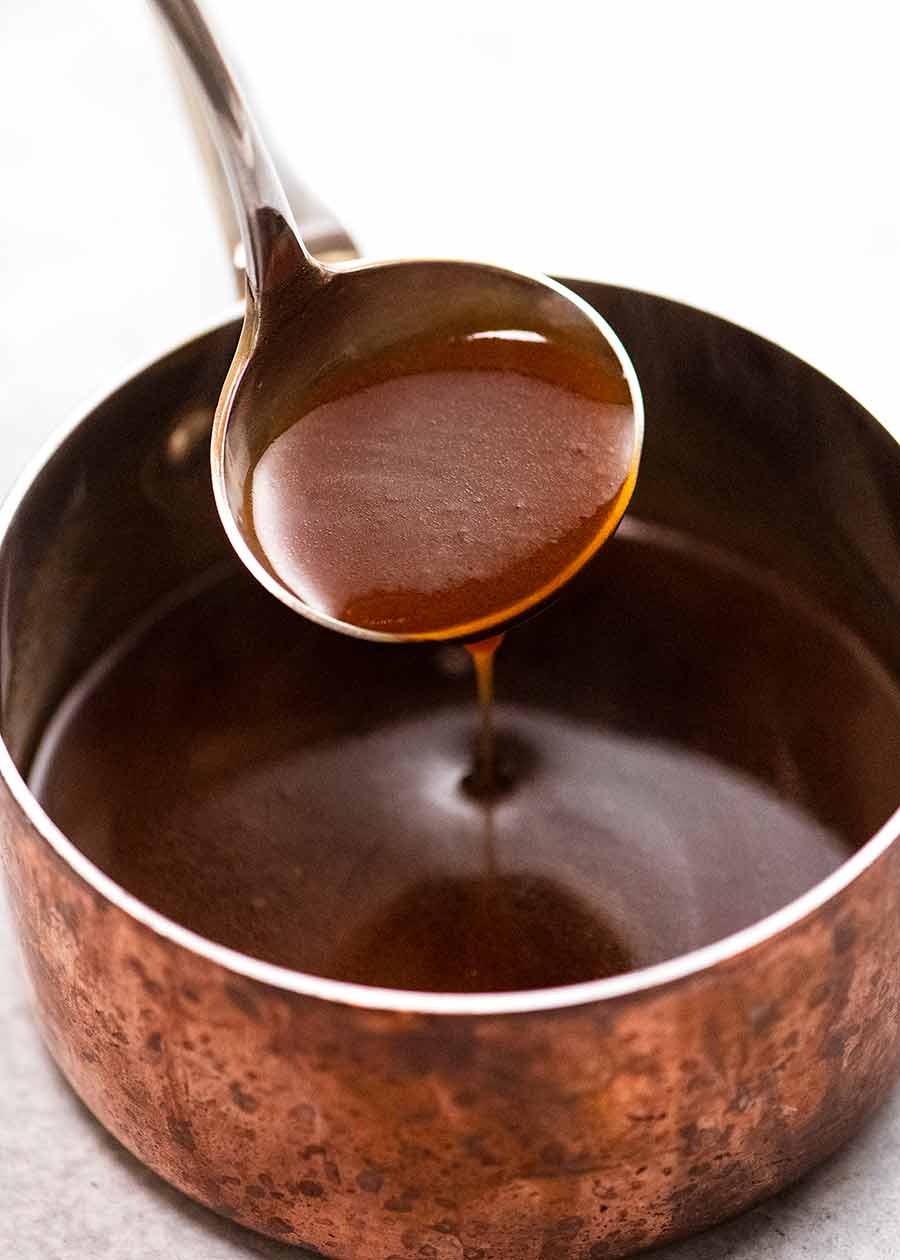
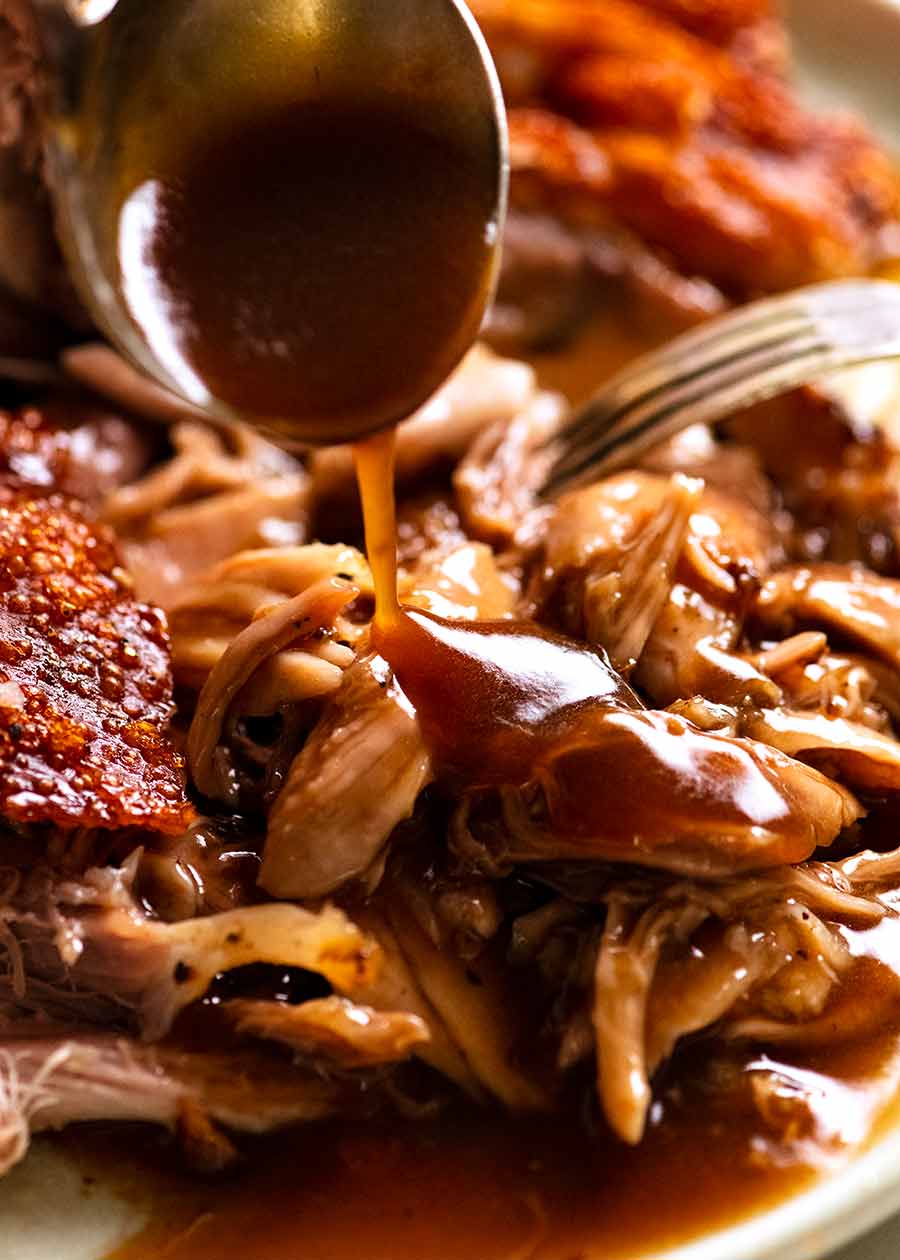
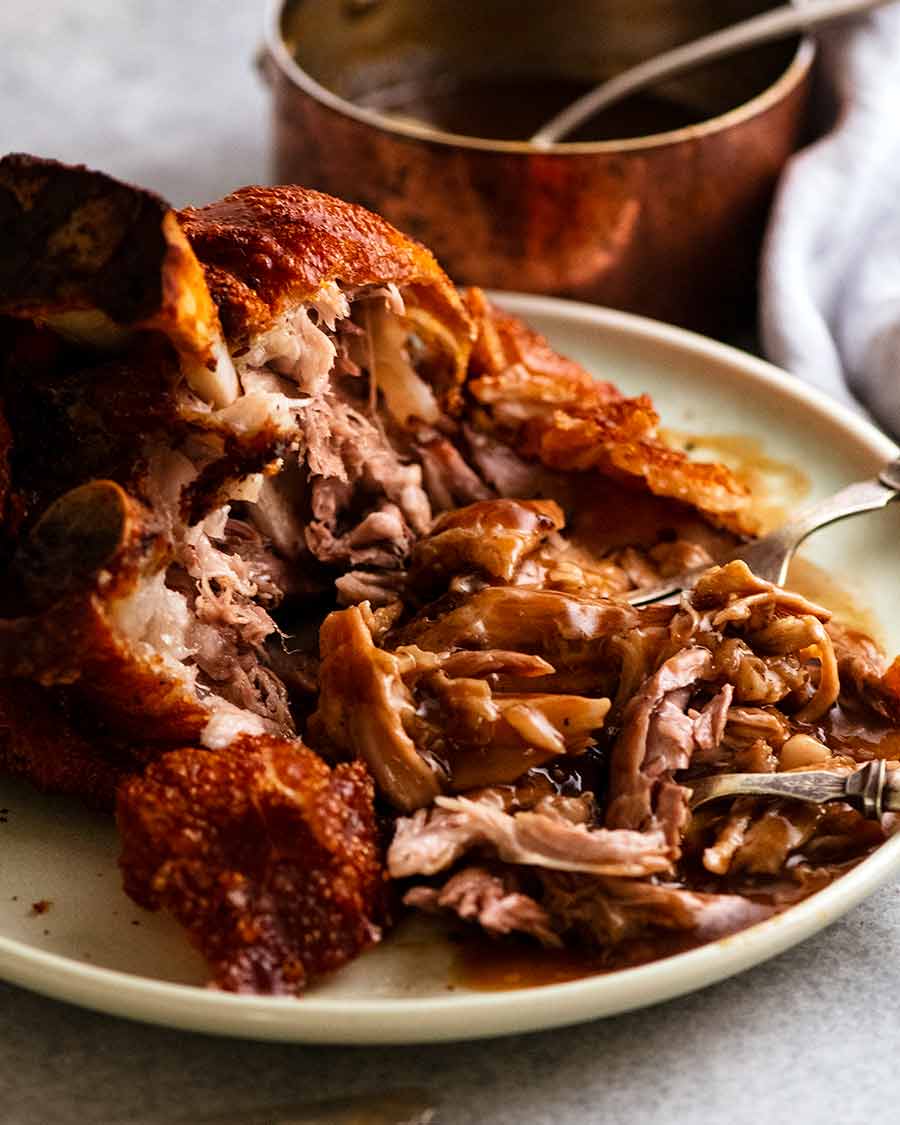
Ingredients for Crispy German Pork Knuckle
First up, you need to get your hands on a pork knuckle. Here is what it looks like:
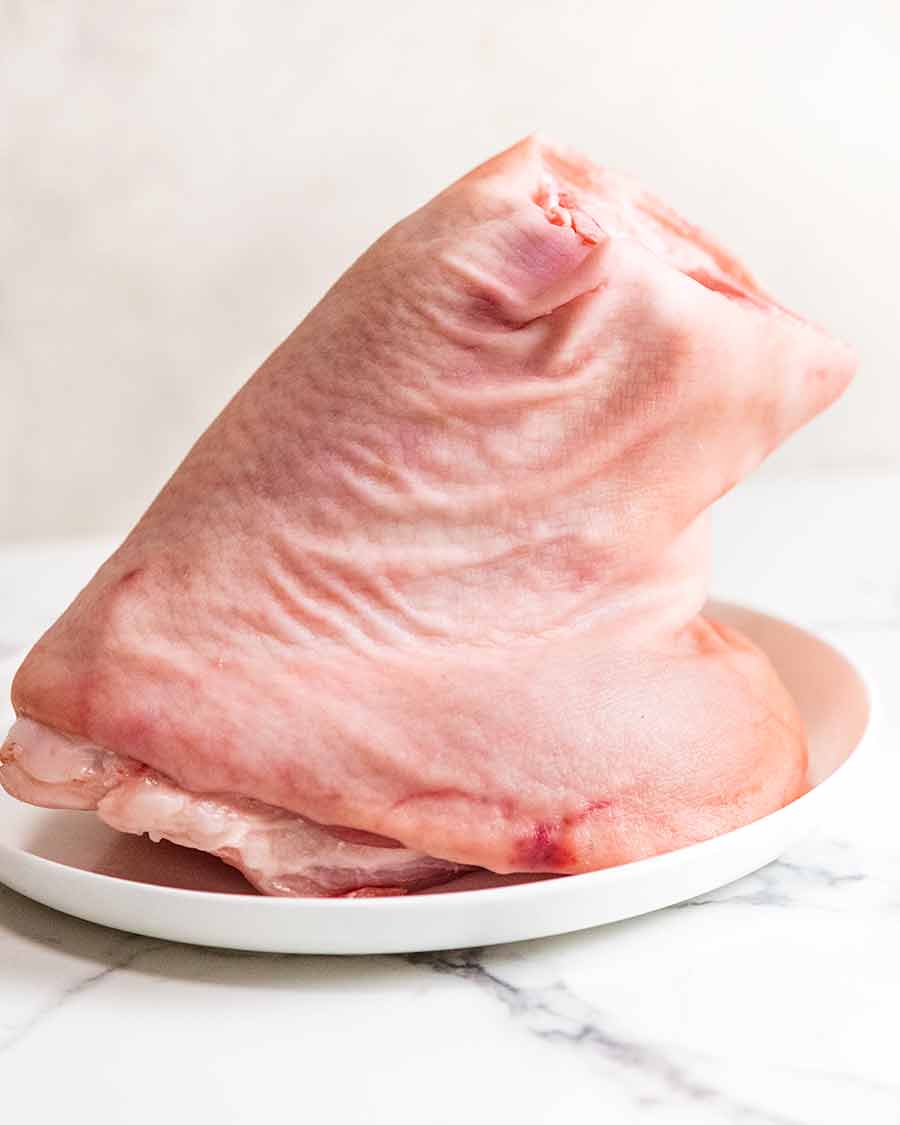
First, pork knuckles are not pig’s feet, despite their name. They are the meaty top part of the pig’s leg. Pig knuckle, pork shanks, pork hock, and ham hock are all names for pork knuckle. The word “ham hock” can also mean smoked or cured hocks. We only need the rear leg knuckles or hocks for German Pork Knuckle because they are bigger and meatier. You can get smaller pork knuckles or hocks from the front legs of a pig. These are often smoked to make smoked ham hocks, which are used in dishes like Pea and bacon.
Note also that sometimes pork knuckles / hocks are sold brined (salted) as pickled hocks or ham hocks. Lightly brined knuckles may be suitable for this recipe, however I have not tested this. We also do not want smoked hocks. I recommend you stick to un-brined, raw pork knuckles / hocks.
One pork knuckle (around 1. 2 – 1. 3kg / 2. 6 – 2. 9lb) is enough to comfortably feed two. If it’s a particularly small knuckle, it will feed one very hungry eater!.
Where to find pork knuckle: In Sydney, you can buy them at some butcher shops, but you may have to ask for them because they may keep them out the back instead of on the counter. However, I found it quite easy to get pork knuckle from Asian butchers. They may have it displayed or stored at the back. They are good value at around $8/kg ($4/lb)! Remember: Ask for rear leg hocks / knuckles. And show them the photo above! .
For some fun facts about food, pork knuckles are often sold at Asian butcher shops because they are a cut of pork that is used in Asian cooking. In Western cooking, on the other hand, the pork knuckle is usually part of the whole ham (leg), which is why it’s not as common to find it on its own at Western butchers. ).
Here’s what you need to prepare the pork for roasting:
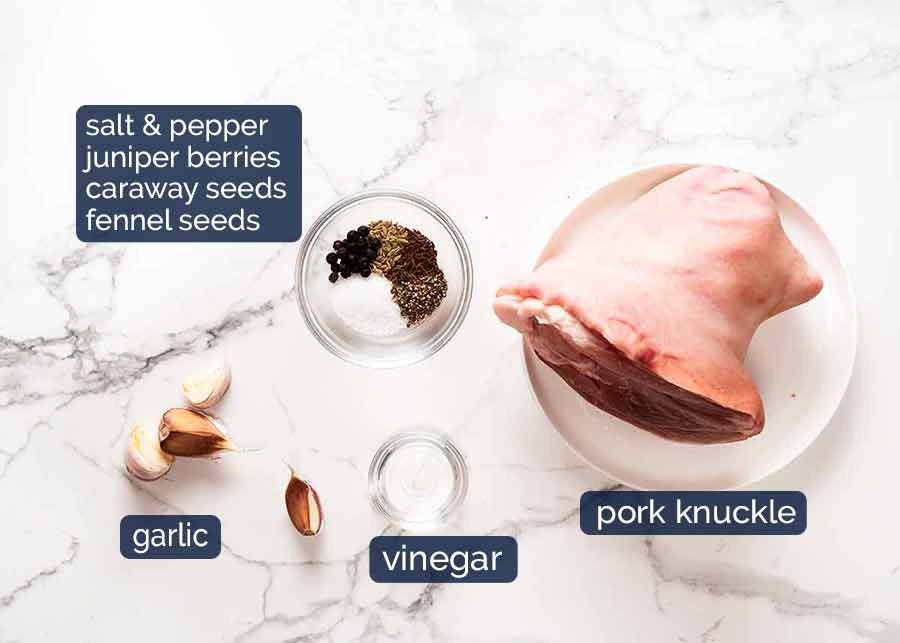
- Some traditional spices that are used to season pork knuckle are juniper berries, caraway seeds, and fennel. However, juniper berries are not as common in Australian grocery stores. They are still easy to find. While spice shops usually have them, delis and fresh food stores that have a good selection of herbs and spices (e.g. Harris Farm);.
- And because garlic is always a good thing, these are cut into thin slices and stuffed into small cuts made in the pork.
- Vinegar: You can brush vinegar on the pork’s meat and skin to get rid of the strong pork smell that can come from roasting secondary pork cuts. This isn’t something that all pork recipes do, but it’s a good idea to do it just in case. It does not make the pork taste “vinegary” at all.
The Ultimate Pork Hock
FAQ
How do you eat pork knuckle?
What side dishes go well with pernil?
What is a pork knuckle dish called?
